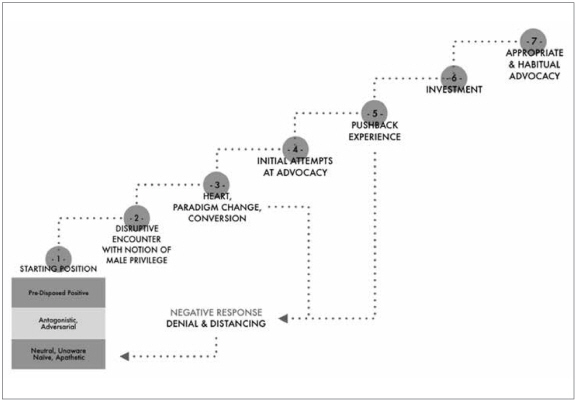Raising Up Allies: A Standardized Pathway For Developing Men Into Allies To Women -- By: Rob Dixon
Journal: Priscilla Papers
Volume: PP 34:3 (Summer 2020)
Article: Raising Up Allies: A Standardized Pathway For Developing Men Into Allies To Women
Author: Rob Dixon
PP 34:3 (Summer 2020) p. 10
Raising Up Allies: A Standardized Pathway For Developing Men Into Allies To Women
Rob Dixon lives in central California with his wife, Amy, and four children and works as a campus minister with InterVarsity Christian Fellowship. He earned a Doctor of Intercultural Studies at Fuller Theological Seminary, where he focused on discerning the attributes of flourishing mixed gender ministry partnerships. Find Rob online at TogetherInMission.net.
In May 2015, in Cardiff, Wales, IBM Global Managing Partner Andrew Grill made an unexpected move at a panel discussion entitled “Online Influence.” The panel was comprised of six men. When a brave woman named Miranda Bishop pointed out the gender imbalance, Grill made his move. Rising from his seat, he offered his chair to Bishop. With encouragement from the crowd, she took his seat. Grill later reported, “Miranda brought an amazing perspective to the panel. . . . The response to our new panelist was extremely positive, as I had expected.”1
Men such as Grill are allies for women. In her book, Becoming an Ally, Anne Bishop defines an ally as “a member of a dominant group who works to end a form of oppression which gives them privilege.”2 As an umbrella term, allyship can include a range of activities, from standing in solidarity, to tangible pastoral support, to empowerment, to advocacy.3 In the area of gender, a male ally seeks to advance the standing of women in his context by every available means.
This article rests on the premise that one strategy for achieving gender equality in the church is developing more men into more effective allies. If our communities of faith can mobilize men to do the work of allyship in partnership with their sisters, we can all more fully live out God’s intention for equal partnership between the genders.
To help with this process, this article will lay out a standardized pathway that men can take on their journey to becoming an ally. Incorporating data gleaned from several one-on-one interviews and a focus group, together with the author’s analysis and personal reflections, this article proposes a seven-step process that communities of faith can use to help shape men into allies to women. The overall route, which will be examined in more detail below, is presented in Figure 1.
1. Starting Position
Generally speaking, men launch into the allyship pathway from one of three starting places. First, they may be predisposed to
Figure 1

You must have a subscription and be logged in to read the entire article.
Click here to subscribe
